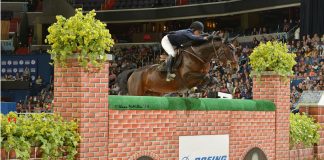Horses aren’t great at staying put. Tying them to an immovable object prevents them from wandering off, but attaching a powerful and inherently reactive animal to something fixed has its risks. A simple way to reduce the perils is by making sure the lead rope is tied at a length that prevents it from becoming an additional hazard.
Even when a lead isn’t long enough for your horse to step a leg over, it still isn’t short enough if he can lower his head and come up with the rope snugged tight across the top of his neck. This can create panic because your horse will feel trapped when his movements are restricted by the rope. Additionally, the angle of the rope gives your horse leverage to brace against. He can get his hind legs way up underneath his body and push back with amazing power. The end result of these forces can be permanent damage to the muscles of your horse’s hindquarters and back, as well as direct injury to his neck. If your horse is also tied on slick footing he could slip and fall as he’s struggling and injure his hocks, etc.

Think about this next time you consider letting your horse graze for a few minutes or eat from his bucket on a long tied line. While it might be a convenience to you, “long-tying” your horse is a habit well worth breaking. It’s never worth the possibility of causing harm to your equine friend. Graze or feed your horse in an enclosed paddock or in hand instead.
When you do tie your horse, drape the lead so your horse can move his head comfortably without dropping his nose below the point of his shoulder. The height at which you tie is important too. Above his head is preferable, but at the height of his withers or above will work. The higher you tie the less leverage your horse will have to work with, diminishing the forces generated against his body, if he pulls back for any reason.
Horses are skilled enough when it comes to getting into trouble and hurting themselves. They certainly don’t need us to help! Tie your horse with the right amount of slack and you’ll being doing your part to keep him safe and sound.
See all What’s Wrong With This Picture videos >>
Dale Rudin is a CHA-certified riding instructor and clinician with a mindful and balanced approach to horsemanship and riding.
www.un-naturalhorsemanship.com






I have seen some nasty rope cuts on horses fetlocks and other rope burns caused by ropes too long.
great info!
a